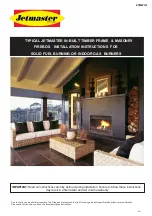
Page 21
March 2000
GB 40 I - FIREPLACE INSERT
VENTING:
TERMINA
TIONS
VENT TERMINATIONS REQUIREMENTS
This unit is equipped with a thermal damper, which has been set at the factory. Do not remove or attempt to
adjust.
The vent termination must be located where it cannot become restricted or blocked by foreign material (for
example, snow and leaves). The vent termination must be above the roof and not below any eaves or
overhangs.
The vent must terminate with an approved cap.
The ANSI 223.1, Section 7.6.2 requires a minimum height above the roof of 1 foot. On installations with
roof pitch greater than 6/12, there must be at least 3 feet of chimney above the roof level, or 2 feet higher
than any point within 10 feet measured horizontally.
NOTE: The installer must take into consideration other factors when determining vent termination height,
such as negative pressure in the home, horizontal sections and offsets in flue system.
Use all required venting components when installing this appliance, and do not mix two or more
manufacturers’ products.
EXAMPLES:
1.
When the vent passes through the ceiling or upper floor, use of a ceiling support or firestop is
required.
2.
Venting through a wall requires a wall thimble.
3.
When vent passes through the roof a proper flashing, storm collar and vent cap are required.
VENTING REQUIREMENTS
PLEASE READ AND FOLLOW ALL VENTING REQUIREMENTS
T
he GB40-I must be installed to follow the CAN/CGA B149 (in Canada) or ANSI Z223.1 (in the U.S.A.)
requirements, and any local codes or regulations of the authority having jurisdiction.
WARNING: This appliance must be installed in an area with an adequate amount of combustion and
ventilation air for it to vent and operate properly. Be sure that provisions for adequate air are made at the
time of installation.
THIS APPLIANCE MUST NOT BE CONNECTED TO A CHIMNEY FLUE SERVICING ANOTHER
APPLIANCE.
This appliance is designed to attach to either 4” diameter type B vent or double thickness aluminum flex
liner, running the full length of an existing masonry chimney. It is designed to be installed into an existing
masonry fireplace or a zero clearance fireplace kit (see page 29 for part number). If installed into a zero
clearance fireplace, you must use B vent pipe. A minimum flue height of 12 feet is recommended. If B
vent pipe is used, it must be supported by vent supports supplied by the vent manufacturer.
This appliance has a draft hood installed at the factory, so no external draft hood is required.
B-VENT CHIMNEY REQUIRES A 1” MINIMUM CLEARANCE TO COMBUSTIBLES.
When venting vertically on exterior of structure, use an insulated venting system or properly built chase
structure to help insulate the vent system. This is recommended due to the low flue temperatures of this
appliance. This also helps prevent the possibility of spillage and draft problems occurring.
















































